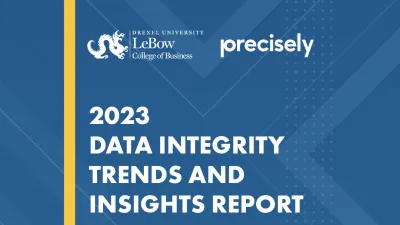
Future of AI and Analytics from Experts: Q&A with Center for Applied AI and Business Analytics Advisory Council
As artificial intelligence (AI) transforms the business world, the Drexel LeBow Center for Applied AI and Business Analytics aims to be at the forefront of the ever-changing field.
The center’s advisory council, comprising AI and data experts from industries including sports, pharmaceuticals, consulting and more, plays a major role in informing forward-looking curricula and programming for current and future practitioners of AI and analytics.
From driving change within leading organizations to empowering students with the knowledge needed to succeed, the advisory council strengthens the alignment of student offerings and industry needs and elevates the center’s external partnerships.
Members of the advisory council discussed insights and challenges in the field, as well as provided advice for those future practitioners who hope to make an impact.
What motivates your involvement in the Center for Applied AI and Business Analytics advisory council?
Andi Lee, vice president of electronics and industrial CIO and enterprise technology at DuPont: I like to be part of influencing our next generation of leaders that will join our companies. We are helping to groom students into young professionals and understand how AI and Analytics can be applied in the real world.
Josh Barbieri, director of business analytics at the Philadelphia Phillies: I enjoy providing feedback from my industry and admire the fact that Drexel evaluates and updates their curriculum accordingly. I also enjoy learning about all the industries represented within the council. It’s a great forum for knowledge sharing that benefits the next generation. I feel fortunate to be a part of the council.
Mark Garvey, retired software sales executive: I joined so I could impact how the next generation of data leaders think about using their imagination and tools to impact how businesses used data to deliver best-in-class results. I have enjoyed helping the University enhance visibility of curriculum and brand presence. The center rebranding to include an applied AI focus shows how much the analytics world is changing, and helping to prepare students for the future is the best part of our advisory council role.
“I am passionate about education, especially in STEM, and the critical role it plays in preparing future innovators during this era of digital transformation and AI.” — Tendü Yoğurtçu, PhD, chief technology officer at Precisely
Elham Alipour, PhD, chief scientist at Charli AI: My motivation for joining the advisory council stems from a strong belief in the transformative power of education in shaping the future of business and technology. I am eager to contribute to the development of cutting-edge curricula that bridge theoretical knowledge with practical application, ensuring students are well-equipped to leverage AI and analytics in real-world scenarios. I am also dedicated to encouraging young women to pursue careers in this dynamic field and ensuring they have the support and opportunities they need to succeed.
Ash Mehta, senior director analyst at Gartner, Inc.: I believe we are at the cusp of extraordinary changes fueled by AI and advanced technologies. I am excited about being part of the advisory council and hope to influence the growth of future leaders who will be able to harness these new technologies to create a better world.
Peter Goodnough, vice president of insights and analytics at Pearson Virtual Schools: I’m very grateful to be part of the council, not least because it provides the opportunity to be close to the energy and curiosity of students just getting into the analytics field. The Analytics and AI space changes so dynamically every year, and it is a privilege to have a window into the cutting edge of what students are interested in learning and to be able to influence the curriculum through the real-time changes we’re all living through in the analytics space.
Tendü Yoğurtçu, PhD, chief technology officer at Precisely: I am passionate about education, especially in STEM, and the critical role it plays in preparing future innovators during this era of digital transformation and AI. Being on the advisory council gives me the opportunity to actively contribute to how programs are designed and developed, ensuring that students are equipped with the knowledge and skills they need to thrive in this rapidly-evolving landscape. I’m also grateful for the opportunity to collaborate with and learn from my peers, gaining new perspectives that will further enrich my contributions.
What aspect of working with data and technology in your specific field do you find most exciting or rewarding?
Lee: Driving business value and growth through emerging technologies – I find it very rewarding when someone in the business, not IT or technology, raves about how an AI or Analytics solution was “instrumental” in helping them enable their strategy, drive growth with customers or, honestly, just helping make their lives easier. I also love seeing our younger, highly-capable technologists interact with more senior leaders where they can see the broader impact of their work.
Alipour: The most exciting and rewarding aspect for me is witnessing the transformative impact of AI-driven innovations on business decision-making and strategy. For example, in the finance sector, generative AI has the potential to create highly sophisticated models that can predict market trends, personalize financial advice, and uncover hidden insights from vast datasets. This not only enhances efficiency and accuracy, but also opens new avenues for strategic growth and risk management. Being at the forefront of such cutting-edge technology and contributing to its evolution is both inspiring and gratifying.
Mehta: I find it very rewarding when the strategic and implementation advice I provide to clients leads to specific and meaningful change. Also, given how fast the fields of AI and analytics are evolving, I find it necessary to be in continuous learning mode, which is energizing.
Yoğurtçu: The most exciting and rewarding aspect for me lies at the intersection of innovation, technology and market trends. Having a strategic view of how emerging technologies can address evolving market trends is crucial in shaping the future. Understanding these trends and identifying emerging customer needs allows for driving impactful innovation and staying competitive. Aligning innovation and technological advancements with real-world applications, contributing to both business growth and the development of educational programs to prepare future leaders are particularly fulfilling.
From your perspective, what are the most significant AI and analytics trends currently influencing business decision making across organizations?
Barbieri: AI from a data perspective helps us make better predictions in real time. It’s also helping us work faster and deliver more. I still think its full potential is not realized yet, but if we continue to have clean, real-time data sets along with the data infrastructure to support the AI evolution, the best is yet to come.
Goodnough: AI, and particularly generative AI, is creating entirely new opportunities to scale data analysis and the resulting execution plans in ways that were unimaginable just a few years ago. There is still a lot of jeopardy in interpreting genAI results uncritically, but the discipline is making very quick strides that will soon change nearly everything about how analytics teams go to market, and that we are all going to have to adapt to in order to stay relevant.
Yoğurtçu: AI and data are poised to revolutionize every industry, creating unprecedented opportunities for individuals who may not have been traditionally technology savvy. However, to truly harness the benefits of AI, including generative AI, and derive trusted results, there are several critical areas we must focus on. First, there is a growing need to invest in AI and data literacy across all levels of an organization. Understanding how to work with data and AI tools is no longer a specialized skill but a fundamental part of decision-making processes. Second, data quality and governance are becoming increasingly important as organizations must ensure their data is integrated, accurate and contextualized, and free from biases. Lastly, as AI technologies rapidly evolve, it’s essential that businesses, educational institutions and governments collaborate to address the potential risks and unintended consequences of AI, including its unsafe or unethical use.
Based on your own experiences and observations in the industry, what advice would you give to students who are interested in pursuing roles that intersect business and technology?
Barbieri: That it’s a great choice. These roles are in demand and help companies generate revenue and save on expenses. It’s all about optimizing the business, and analytics can help achieve this. It’s important to learn a programming language to set yourself apart as this field has become more and more competitive. We recently received over 3,000 applications for two open positions within our group. We are seeing a diverse influx of candidates with degrees in business analytics, data science, and AI to name a few. Supply is increasing, so you need to think of ways to differentiate yourself.
Garvey: The intersection of business and domain knowledge with strong technical skills is generally going to be the most interesting place for opportunity. I would look for places in a business where your technical skills can be used within the business processes.
“I’ve worked with recent Drexel graduates and have always been impressed by how quick they are to embrace new challenges and come up with really creative ways to solve business problems.” — Peter Goodnough, vice president of insights and analytics at Pearson Virtual Schools
Alipour: Seek opportunities for hands-on experience through internships, projects or industry collaborations. By working on applied problems, you’ll build a strong portfolio, enhance your technical and business skills and gain a clearer perspective on the practical applications of your studies. Additionally, embrace continuous learning, as both technology and business landscapes evolve rapidly.
Goodnough: It’s an exciting time to be entering the analytics field. I think the most important step you can take to make yourself invaluable is to get as close to a 360-degree view of the business you’re in as you can. When you understand how your business makes money and all the different levers that can accelerate it, you’ll be in a much better position to develop great analytics that impact the top and bottom lines.
What types of challenges might future professionals encounter in their AI and analytics careers, and how can they anticipate or prepare for them?
Lee: It’s important to keep in mind the pace of change and speed at which traditional companies can adopt new technologies. Not only how to implement the technology, but ensure it is adopted. Ongoing concerns with data privacy, security and bias are putting more emphasis on responsible AI.
Garvey: As analytics has become commoditized and as AI will follow, different businesses will rely on different technologies and vendors to provide solutions. The challenges of learning and integrating new vendors and products will be both rewarding and stifling. Staying focused on the core data, building your business knowledge so you are constantly curious about the data and potential results and developing an imagination about what else might be possible with tools and data is the best preparation for always being a valuable resource.
Goodnough: Analytics is a field of lifelong learning. While the foundational elements of math and data analysis will hold you in good stead throughout your career, your technical skills will have to upgraded frequently. You’re off to a great start, but never forget that if you’re not learning something new every day, you’re falling behind.
Yoğurtçu: Another challenge is ensuring data integrity. As AI is increasingly influencing decision-making, the accuracy, context and ethical use of data will be critical. Professionals will need to develop strong skills in data management, such as data quality and governance, to ensure reliable outcomes. The integration of AI into business strategies will not only require technical expertise but also deep understanding of the business goals. Professionals will need to connect AI solutions to business outcomes to drive success.
How might you assess the readiness of LeBow business analytics students for their future careers?
Barbieri: I would consider them ready to go knowing all that I do about the program. I think fine tuning the soft skills that go along with presentation, storytelling and communication is key to landing a job in today’s market. Just as the tools used in this industry are evolving, so is the need to be able to explain how they all work in a simplified manner and how they add business value.
Alipour: The capstone project is a great way for students to tackle real or simulated business problems. By working on these projects and collaborating with industry professionals, students gain practical insights into problem-solving, build a robust portfolio and demonstrate their capability to handle real-world challenges, preparing them well for their future careers.
Goodnough: I’ve worked with recent Drexel graduates and have always been impressed by how quick they are to embrace new challenges and come up with really creative ways to solve business problems. The fact that a Drexel education focuses so strongly on solving real-world business problems provides a great edge to every Drexel graduating class.
Yoğurtçu: The LeBow College of Business, specifically the Center for Applied AI and Business Analytics, does a great job staying on top of market trends and partnering with industry leaders. Through co-op programs, internships and capstone project partnerships, students gain valuable hands-on experience, applying their academic knowledge to current business challenges. This practical exposure, combined with the program’s strong leadership, ensures students are well-prepared to meet the demands of the evolving job market.


